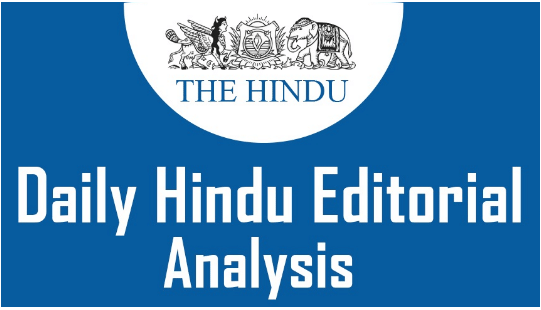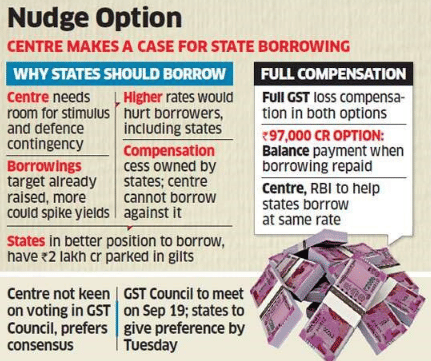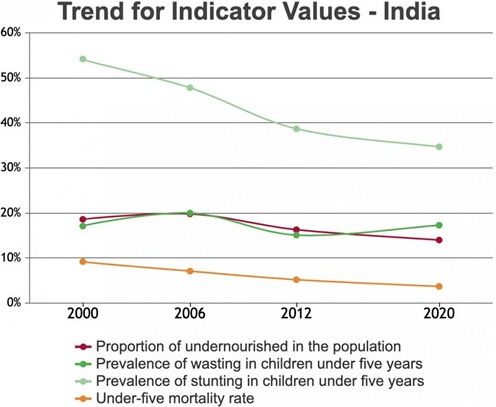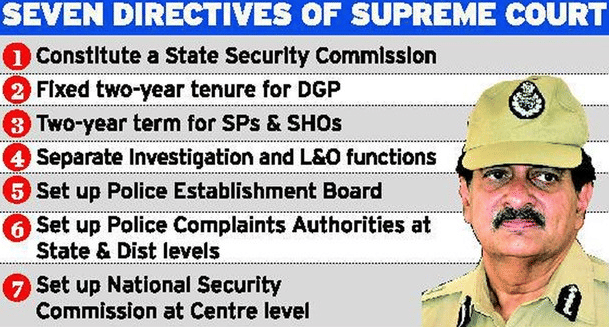The Hindu Editorial Analysis- 19th October, 2020 | Additional Study Material for UPSC PDF Download

1. AN INCOMPLETE SOLUTION: ON CENTRE BORROWING FOR STATES-
GS 3- Indian Economy and issues relating to planning, mobilization of resources, growth, development and employment
Context
(i) The past week witnessed some forward, albeit(although) inexplicably delayed, movement towards breaking the deadlock between the Centre and States.
(ii) Past few weeks Centre and States were locked on bridging this year’s shortfall in cess(tax on tax) collections to recompense States for adopting the GST.

Centre’s Approval
(i) Following a lack of consensus at a 3rd meeting of the GST Council on the issue last Monday, Finance Minister said States that had agreed to the Centre’s proposal could begin borrowing from the market.
(ii) To recap — the Centre had argued that just ₹1.1-lakh crore of the estimated ₹2.35-lakh crore shortfall in GST cess inflows was due to GST implementation; the rest was due to COVID-19.
(iii) States could borrow ₹1.1-lakh crore with interest and principal payments to come from future cess collections; or borrow the ₹2.35-lakh crore, but bear the interest from their coffers.
(iv) By Wednesday, 21 States had agreed to the Centre’s first option and were permitted to raise about ₹79,000 crore (0.5% of their gross State domestic product as additional borrowing linked to their acceptance of the option.
(v) On Thursday, however, the Centre changed tack and said it was now willing to borrow the ₹1.1-lakh crore and lend it onward.
(vi) Calling this an administratively easier measure to ensure States do not end up borrowing at different interest rates, the Ministry asserted this would neither increase the fiscal deficit nor the general government debt.
Fiscal Math Worry
(i) States and economists have welcomed this change of heart, especially as it helps bring in much needed cash for States to fight the pandemic.
(ii) However, it is odd that the ‘administrative ease’ of the Centre borrowing and lending to States, had not struck North Block mandarins(experts) earlier.
(iii) Given that the cess collection worries surfaced soon after the lockdown was imposed, it should have been an easy call for the Centre to borrow and lend it to states.
(iv) Over the course of the negotiations, States had urged the Centre to borrow and pay them, but the Finance Ministry had repeatedly stressed that this would push up interest rates and upset its fiscal math.
(v) Precious time could have been saved had the Centre made this offer earlier.
(vi) So far the States have only received ₹20,000 crore from the GST cess.
(vii) Kerala, which was considering a petition in the Supreme Court with other Opposition-ruled States, has cooled off on the legal route, but sought full payment of the ₹2.35-lakh crore shortfall this fiscal.
(viii) On Friday, Ms. Sitharaman wrote to Chief Ministers suggesting that the ₹1.1-lakh crore, in addition to the 0.5% of GSDP borrowing, would give them ₹2.16-lakh crore, or almost 90% of the compensation shortfall.
Conclusion
(i) Cash flow assurances aside, the Centre must now talk to States to ensure greater clarity on the unanswered questions — including when the States will get the balance GST compensation.
(ii) That is imperative(need) to sustain the fragile(weak) peace attained for now.
(iii) The Centre must assure States on the timeline for payment of the GST compensation due.
2. NO GREAT ESCAPE: ON INDIA’S LOW RANK ON NUTRITIONAL INDICES-
GS 3- Issues related to direct and indirect farm subsidies and minimum support prices; Public Distribution System objectives, functioning, limitations, revamping; issues of buffer stocks and food security
Context
India’s poor progress on nutritional indices must dispel(dismiss) the hubris(pride) surrounding strong economic growth for years, and turn national focus on persisting hunger, wasting and stunting among children.

Decline In Ranking
(i) This year’s Global Hunger Index places India in the company of Sudan — rank 94 among 107 countries — with the unedifying(unpleasant) assessment of the national situation as “serious”.
(ii) The country’s score of 27.2 is the worst among BRICS countries, and inferior to Pakistan, Sri Lanka, Bangladesh and Nepal.
(iii) The GHI is developed around wasting and stunting (under five), the share of the population with insufficient caloric intake, and child mortality(death).
(iv) Index scores by international agencies have been critiqued as flawed for choosing the wrong weights in scoring, and also for not including genetics and social determinants, but that would be a narrow view.
(v) The evidence from the NFHS-4 of 2015-16 is not very different.
(vi) The reality is that national policy has no appetite(hunger) for a radical transformation in the delivery of adequate nutrition especially to women and children,
(vii) The policy has paid inadequate attention to achieving diet diversity through the PDS.
(viii) On the other hand, the country is widely seen as falsely equating energy calories with a diverse diet.
(ix) The existing deprivation has been aggravated by the pandemic, with food inflation putting pressure on depleted(reducing) incomes or meagre pensions and savings.
Worrying Indications
(i) The NFHS-4 found that under-five stunting from chronic undernourishment stood at 38%, and wasting, a result of acute lack of nutrition, at 21%.
(ii) These data represent some progress, at a drop of about 10% points in both categories compared to a decade earlier, although steady economic prosperity should have yielded a far bigger social dividend.
(iii) The latest GHI measure is a reminder that much work is necessary to bring the true benefits of the National Food Security Act to the unreached, not merely as hunger mitigation(reduction) through cereals, but as nourishment through a diverse diet that includes fat, protein and micronutrients.
(iv) But there are worrying indications that the Centre has chosen the wrong course.
(v) In its pursuit of fraud within the PDS, it is inclined to take hard measures that would deprive the disabled and the elderly of even cereals, by insisting on biometric verification to get supplies.
(vi) Strengthening the PDS, with a focus on women’s health, would lead to healthier pregnancies, and stronger supplemental nutrition under the ICDS scheme would give children a better chance at all-round development.
(vii) The importance of sustained, immediate intervention is further underscored by recent findings of International Food Policy Research Institute scholars that three out of four rural Indians cannot afford a balanced, nutritious diet.
(viii) The right to food would be meaningless if it leaves a large section of Indians hungry, stunted and wasted.
Conclusion
India’s low global rank in tackling nutritional deficits calls for a revamped(rebuilt) PDS.
3. STILL AWAITING POLICE REFORM-
GS 2- Important aspects of governance, transparency and accountability
Context
(i) Police brutality(cruelty) in recent months has turned quotidian(everyday).
(ii) The thrashing of a Dalit Ahirwar couple by the police in Guna district of Madhya Pradesh on July 14 was very distressing.
(iii) But for the media coverage, the incident would have gone unnoticed.
(iv) The District Collector and the Superintendent of Police have been transferred and six police personnel have been suspended since the incident.
(v) The matter will soon be forgotten.

Remedial Measures
(i) The public outcry following the brutal torture of J. Benicks and his father P. Jayaraj in Thoothkudi district of TN resulting in their death had still not died when news came that a gangster, Vikas Dubey, was killed by the UP police in Kanpur when he allegedly tried to flee from custody.
(ii) The police version of the incident was quite unbelievable. It looked like the law had been subverted(overthrown).
(iii) These incidents and several others show that we need immediate remedial measures lest the country witnesses an upheaval(disruption) of the kind that the U.S. saw following the death of George Floyd.
(iv) Should such a situation arise, it will be the political class that will squarely be held responsible.
(v) Political class have been the stumbling block in the implementation of various apex court directives aimed at improving the functioning of the police.
Solutions That Remain On Paper
(i) Commissions and committees are set up every time there are demands for police reforms after a major incident.
(ii) Then the recommendations of such commissions and committees are simply consigned to the archives.
(iii) But they are not forgotten as some senior police officials vociferously(earnestly) demand implementation of their recommendations from time to time.
(iv) The first serious attempt to overhaul(repair) the policing machinery was made when the National Police Commission (NPC) was set up in 1977.
(v) The NPC submitted eight reports to the Ministry of Home Affairs between 1979 and 1981.
(vi) Seven of these reports were circulated to the States in 1983 with an annotation that “the Commission has been unduly critical of the political system or the functioning of the police force in general”.
(vii) In a subtle manner, a signal had been sent.
(viii) The report was put in cold storage(delayed) until Prakash Singh, a retired IPS officer, filed a PIL in the apex court in 1996 demanding the implementation of the NPC’s recommendations.
- In 2006, the Supreme Court issued a slew(series) of directives on police reform.
- These would have had a far-reaching impact had the States and the Centre paid any serious attention to them.
- But that would have upset the applecart of our politicians and even the bureaucrats, some of whom are known to be corrupt and mired in crime.
- According to a report by the Association for Democratic Reforms (2018), there were 1,580 MPs and MLAs facing criminal charges.
- Therein lies the crux of the matter.
Turning A Blind Eye
(i) The one diktat that would hurt the most is the setting up of a State Security Commission (SSC) in each State which would divest the political leaders of the unbridled power that they wield at present.
(ii) Of the States that constituted an SSC, only Andhra Pradesh and Karnataka have made SSC recommendations binding on the State government, according to the Commonwealth Human Rights Initiative.
(iii) Only six States provided a minimum tenure of two years to the Director General of Police (DGP).
(iv) In Tamil Nadu, T.K. Rajendran, who was made DGP (Intelligence) and given full additional charge as DGP in September 2016, was formally appointed DGP on the day he attained the age of superannuation.
(v) (A superannuation is an organizational pension program created by a company for the benefit of its employees)
(vi) Many States have not implemented a single directive of the Supreme Court.
Conclusion
(i) Since expecting political will to implement police reforms is a far cry, it is for the judiciary to step in and enforce the diktats it had passed.
(ii) Fourteen years is too long a period for any further relaxation.
(iii) The Court has to come down heavily on the States and the Centre to ensure that its directives are not dismissed lightly.
(iv) A bold step towards bringing down crimes is possible only when the politicians-criminals-police nexus(connection) is strangled.
|
21 videos|562 docs|160 tests
|
FAQs on The Hindu Editorial Analysis- 19th October, 2020 - Additional Study Material for UPSC
| 1. What is the significance of the Hindu Editorial Analysis for UPSC preparation? |  |
| 2. How can the Hindu Editorial Analysis help in improving English language skills for UPSC? |  |
| 3. What are the key areas covered in the Hindu Editorial Analysis that are relevant for UPSC exam preparation? |  |
| 4. How can one use the Hindu Editorial Analysis effectively for UPSC preparation? |  |
| 5. Can the Hindu Editorial Analysis be used as a standalone resource for UPSC preparation? |  |
















